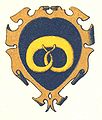Bajgle, precle, obwarzanki
Przejdź do nawigacji
Przejdź do wyszukiwania
Spis treści
Precle
- EUR-Lex: Bayerische Breze
- Geographische Verteilung der Bezeichnungen: Bre(t)z
- Wer hat die Brezel erfunden?
- First of all, the pretzel was not "invented", but its present form has gradually developed over the centuries. The origins of the pretzel lie in the ring bread, which was used for ritual acts already in ancient Rome. Already in the 2nd century, the early Christians adopted the ring-shaped loaf of bread (to a lesser extent) as Eucharistic bread, ie for the Lord's Supper.
- Thus, the former ring-shaped cult bread from Rome received a Eucharistic character, which the biscuits retained until after the Middle Ages, but in the course of time changed its appearance: starting from the more or less round original form over the opening of the ring bread to a 6-like Form, the doubling and the juxtaposition of two 6-forms to the interlocking of the inner pretzel arms into a knot.
- Since the development of the pretzel was no longer known for a long time, many legends arose to explain this phenomenon. A story, for example, describes that the pretzel is the representation of the arms of a monk, crossed to prayer. Another, far less pious story tells of the baker Frieder, who fell out of favor with Count Eberhard in Urach and was sentenced to death. However, Frieder had the opportunity to save his life if he could bring in three days a pastry through which the sun could shine three times. Once again, the crossed arms of the puzzle are the solution when Frieder's wife is standing in the doorway with her arms folded, after her husband had spent nearly three days in panic inventing a pastry. When the cat inadvertently throws down the metal sheet with the finally designed new baking creation and lands everything in a lye pan, the fright is great and Frieder is slowly all but matter. He simply pushes the licked dough pieces into the oven. But the result can be seen: The pretzel was said to have been invented, and thus Frieder could save his life. - The present form of pretzel, however, was already known in the late 12th century, that is already about 200 years before Count Eberhard (1445-1496) lived in Urach.
- The pretzel quickly became the icon of the bakers due to its unusual shape. Already around 1300 you can find them on their official guild seals. This has remained so until today.
- The pretzel belongs to the family of the so-called "Gebildbrote", a type of pastry that forms a structure by hand (such as the braid). When asked where the top and bottom of the pretzel are, one usually gets two different answers: one group claims that the arms are down, and the other group is convinced that the arms are up and the stomach down. In fact, there are also guild coats of arms, on which the arms show to the side! How about the pretzel really belongs? Statistically, the pretzel is shown in most baker guilds and guilds in the crest with the belly up and the arms down. Where up and where is down, but is not fixed.
- Only the German Bakers Association had in its stylized "sympathy" of the 1970s / 80s, the arms of the pretzel above. When the sign was modernized in the 1990s, the pretzel was turned the other way around. Incidentally, the pretzel is usually eaten with pleasure, and then the "right" orientation of the pastry becomes a personal matter of taste.
- L’histoire de la Bretzel selon l’Hortus Deliciarum
- Die älteste Brezel der Welt
Obwarzanki
- EUR-Lex: Obwarzanek krakowski
- Izabela Czaja, Marcin Gadocha: Obwarzanek krakowski: historia, tradycja, symbolika, Kraków: Bartosz Głowacki, 2008
- Maria Dembińska: Food and Drink in Medieval Poland: Rediscovering a Cuisine of the Past, red. William Woys Weaver, Philadelphia: University of Pennsylvania Press, 1999
- Alexander Przezdziecki: Życie domowe Jadwigi i Jagiełły: z regestrów skarbowych z lat 1388–1417, w: Biblioteka Warszawska, 2, Warszawa: Drukarnia Stanisława Strąbskiego, 1854, s. 299–320
- Simit
- Ka'ak
Bajgle
- Maria Balinska: The Bagel: The Surprising History of a Modest Bread, New Haven and London: Yale University Press, 2008 [1]
- Pretzel; in: The Oxford Companion to American Food and Drink
- Pretzel; in: The Oxford Companion to Food
- Lox; in: Savoring Gotham: A Food Lover's Companion to New York City




